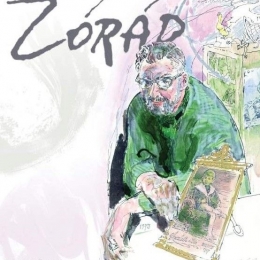art or business
Ernő Zórád's Youths of an Itinerant Painter
At the exhibition the spectator reencounters the originals of the illustrations. Zórád, the comic artist, can easily be recognised by the personally inspired colourful aquarelles of his autobiographically inspired novel - as well as from its journal-like collages of newspaper articles, drawings and photographs, reminiscent of the tone and imagery used by the Hungarian press in 20s and 30s (publications such as the Fidibusz , the "piquant Flirt ", or even the Sporthírlap or Magyar Cserkész ). Notes and fragments of letters written to Zórád appear on the collages. Next to the photos, he applied his own drawings and sketches.
While in 2001, we presented Zórád's comics, through this exhibition we would like to honour him as a graphic artist and aquarellist. The pieces of Zórád's supreme imagery, unique both in form and content, belong among the masterpieces of Hungarian graphic art.
The illustrations, paintings and stories which appear in the book could perhaps be seen as the autobiography of the last true gentleman. He was a picture hawker, a football player, an amateur actor and singer in tenement courtyards.
He lived in country-houses, in slum hovels and in Pest's luxurious inn called The Queen of England. Tempestuous love affairs and nights spent in revelry. Women, women and women; voluptuous blonds, sensuous brunettes and black-haired demons. This was one of his lives. His other life was that of the wizard of Tabán, the world-famous painter and graphic artist.
Ernő Zórád's Youths of an Itinerant Painter 1911-1951 can be purchased in larger bookshops and the kArton Galéria.
Zórád Ernő
(Balassagyarmat, 16 October 1911)
painter, graphic artist, illustrator, comic artist
Ernő Zórád studied at the School of Applied Arts between 1927 and 1929, with Jenő Haranghy as his master. In 1947, he began working for the publication Magyar Vasárnap ("Hungarian Sunday"). He also worked for the illustrated and humorous weekly, Pesti Izé ("Thing of Pest"), until the cease of its publication. His first exhibition was in 1947 in Budapest. He then took part in the third, forth and fifth Hungarian Fine Art Exhibition. His works appeared in a number of group exhibitions in
various countries. In 1970 he was invited to the Salone del Comics festival in Rome, where the works of the twenty best comic artists of the world were exhibited.
Solo exhibitions: "Irodalmi pantheon" ("Literary Pantheon") theme: Derkovits Terem (1960), Csók István Galéria (1981), Debrecen (1987), Írószövetség (1996). His Tabán paintings, exclusively, were exhibited in the Derkovits Terem in 1983, 1985 and 1989-
ben. In 2000, a solo exhibition opened in Duna Galéria and, in 2001, in kArton Múzeum and Galéria. In 2003 his works were exhibited at the Petőfi Irodalmi Múzeum (Petőfi Literary Museum) and the Francia Intézet (French Institute). He contributed to the success of Hungarian filmstrip. He established a high standard for comic art. He is one of the greatest, internationally recognised representatives of the genre. As of 1951 he worked for the Magyar Ifjúsági Lapkiadó (Hungarian Youth Publishing), then, for forty years, he worked for the publication Füles. In 1990, his autobiographical novel, Youths of an Itinerant Painter , was published. In 1997 the Tabán was published with his works and under his editorship. In 1998 Krúdy világa ("Krúdy's World") was published. His works can be seen in Balassagyarmat and Ipolyság (Sahy) at the Városi Képtár (City Art Gallery). "(.) his humour and flavourful satire can deliver a striking slash as well as a pat on the shoulder, he makes no misjudgement in the matters of scale and proportions. (.) His drawings, which were not meant as illustrations, are nevertheless great illustrations of a the life and literature of a great era." /István Solymár/ In 2000, as a gesture of recognition, the Municipality of Budavár awarded Ernő Zórád the "Honorary Citizen of Budavár" title. He was also awarded the Officers' Cross of the Order of Merit of the Hungarian Republic.
A wizard. He writes with emotion about a sensuous era.
György Faludy
.It is not particular scenes that are described, rather the era, itself.
(Népszabadság)
It is as if emotion and irony, melancholy and roaring laughter left the tip of Zórád's pen all in the same instance .
( Magyar Nemzet )
,,...There is no way for us to know how many days, or lamp-lit evenings Zórád spent with Mikszáth telling anecdotes at coffee house tables, how many times he stole glances
through the windows of worldly ladies as if he were Sinbad following Krúdy's magic spell, how many times he stood at the racecourse with tickets in his hand, falling under
the spell of a face or movement and forgetting about winning. It is a fact that he brings fin de siecle literary characters to life, and the reminiscing, ultimately, gains validity through today's perspective.
(Art). It would be good to see THIS in Paris too!
Michel Gyarmathy
Director of the LIDO in Paris
"I need a hundred pages to say what he expresses with a single line.."
Sándor Márai

